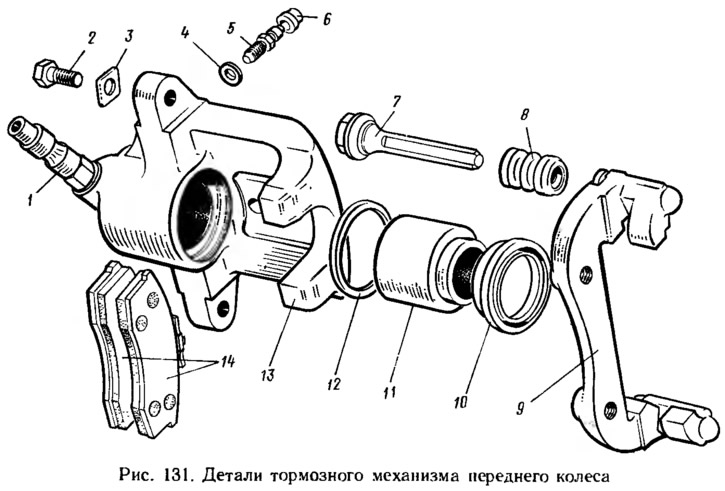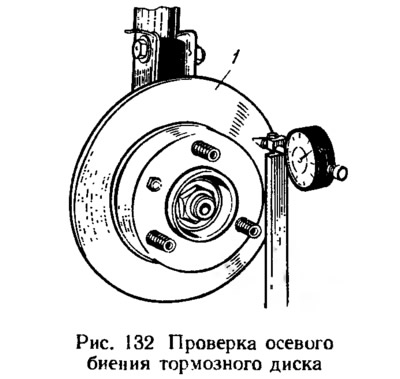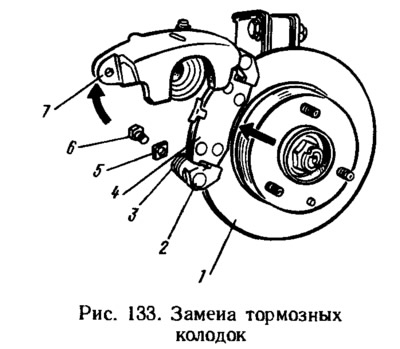Removal and installation
Raise the front of the car and set it on stands, remove the wheel. Unscrew the fitting of the pipeline and disconnect the flexible hose from the line; the hose and tube opening is plugged to prevent leakage of brake fluid. Remove the hose from the guide bracket.
Remove two screws 1 (see fig. 125), with which the shoe guide is attached to the steering knuckle, remove the guide assembly with the caliper and cylinder.
Installation of the brake mechanism is carried out in the reverse order of removal. After installation, the brake fluid level in the reservoir is restored and the hydraulic drive system is bled to remove air.
Disassembly and assembly
Disconnect hose 1 (pic. 131) from the wheel cylinder. Unchecked (bend washers 3) and unscrew the bolts 2 for fastening the caliper 13 to the fingers 7, holding the guide pin with a key. Remove the brake pads 14. Remove the protective cap 10 from the cylinder and piston. Gently forcing a jet of compressed air through the fluid inlet, pushes the piston 11 out of the cylinder. In order not to damage the piston on the surface of the caliper when pushing out, a wooden lining is installed under the piston.

The fitting 5 with cap 6 is unscrewed from the cylinder body and the working surface of the cylinder is carefully inspected. It must be free of scratches, damage and corrosion.
Assembly of the brake mechanism is carried out in the reverse order of disassembly. At the same time, sealing rings 4, 12 (see fig. 131) and cap 10 are recommended to be replaced with new ones. The mirror of the cylinder, piston 11 and sealing ring 12 are lubricated with brake fluid, and graphite grease is applied to the piston surface, the piston is installed in the cylinder and, without removing grease residues, protective cap 10 is put on so that its edges enter the grooves of the piston and cylinder. Guide pins are lubricated with UNIOL-1 grease. Bolts of fastening of a support with the cylinder tighten the moments specified in appendix. 1, after which they will be countered. After assembling and installing the brake mechanism, the fluid level in the reservoir is restored and the hydraulic drive system is bled.
Checking the technical condition
Clean all parts and carefully check their condition for signs of wear, damage or corrosion. Particular attention is paid to the surface of the piston and cylinder. If they are worn, damaged or severely corroded, the cylinder and piston are replaced. Corrosion is removed from the cylinder body with a wire brush.
Check guide pins 7 (see fig. 131) and their covers 8. Make sure that there is no corrosion and damage on the fingers, that they do not stick in the holes of the guide. Fingers should move freely. In case of corrosion and damage, replace the fingers and protective covers with new ones.
Check the condition of the brake disc. On its working surface, scuffing and deep scratches, as well as other damages that increase wear of the linings or reduce braking efficiency, are not allowed. Check the thickness of the disc, which must be at least 7.8 mm. If the thickness is less than specified, replace the disk. Grinding or turning of the disc is allowed, but both sides must be machined to the same depth, and the thickness of the disc should not be less than 7.8 mm.
Brake pads are replaced with new ones when the pads are worn to a thickness of 1.5 mm. Pads are replaced simultaneously on both brakes (both pairs of pads). Check the condition of the pad springs. In case of loss of elasticity or their breakage, the springs are replaced.
Checking brake disc runout
Check the axial runout of the working surface of the brake disc 1 without removing it from the car (pic. 132). The largest allowable runout on the indicator is 2-0.15 mm. If the runout is greater, replace the disc or grind it, but the final thickness of the disc must be at least 7.8 mm.

Replacement of brake pads
If it is necessary to replace the brake pads, bend the corner of the lock washer 5 (pic. 133) from the edge of the lower bolt 6, unscrew it, holding the guide pin 3 with a wrench. Then turn the caliper 7 together with the cylinder relative to the other pin, remove the brake shoe from the piston side and release the caliper to the working position. Carefully, so as not to damage the dust cap and prevent the brake fluid from splashing out of the master cylinder reservoir, move the piston as far as possible inside the cylinder, pushing off the surface of the brake disc 1 with a screwdriver. Raising the caliper, replace the worn outer pad 4 with a new one and lower the caliper to its working position. Once again, the piston is moved inside the cylinder and, having raised the caliper, a new inner brake pad is installed. Having lowered the caliper, wrap and lock the bolt 6.

If the liquid level in the master cylinder reservoir approaches or corresponds to the maximum, then before sinking the piston, remove part of the liquid to prevent it from splashing out.
When replacing the pads, check the condition and fit in the sockets of the protective caps of the pistons and covers of the guide pins. If necessary, replace them or ensure the correct fit in the socket. Check the fastening of the guide 2 pads.
